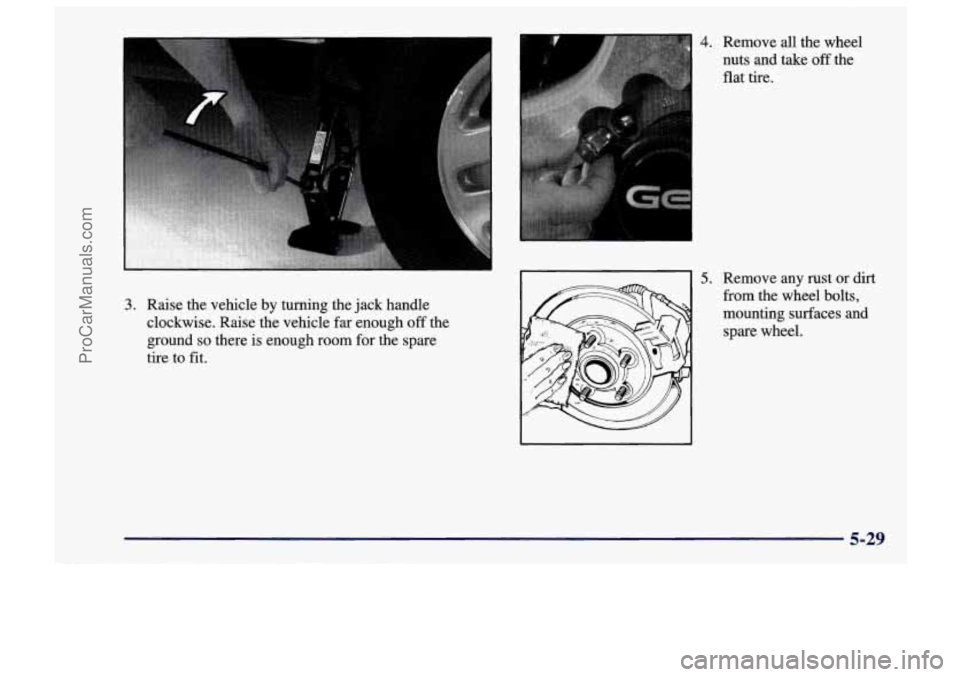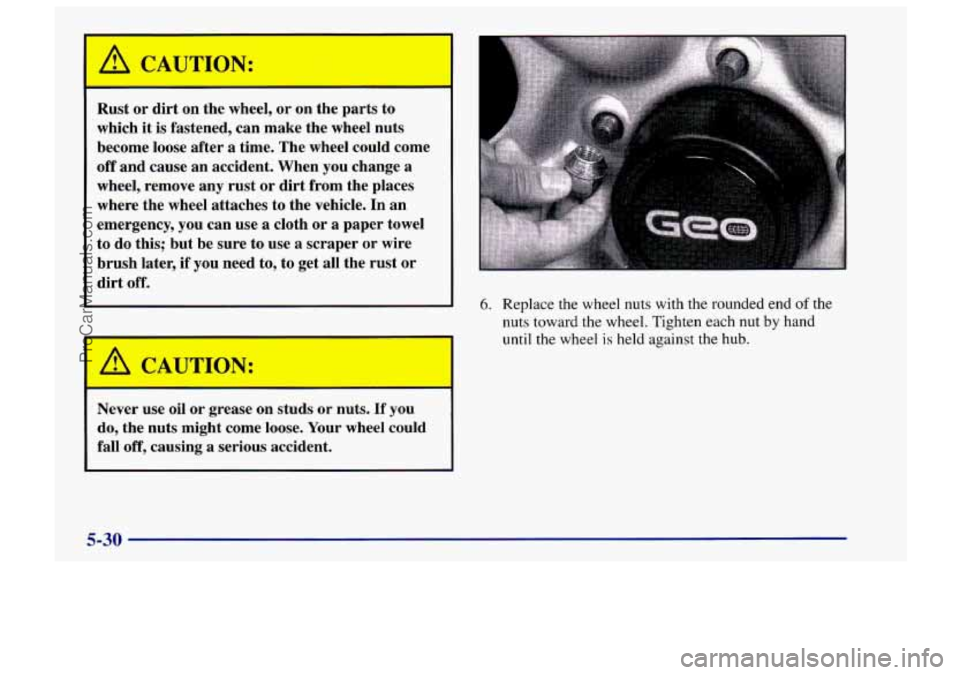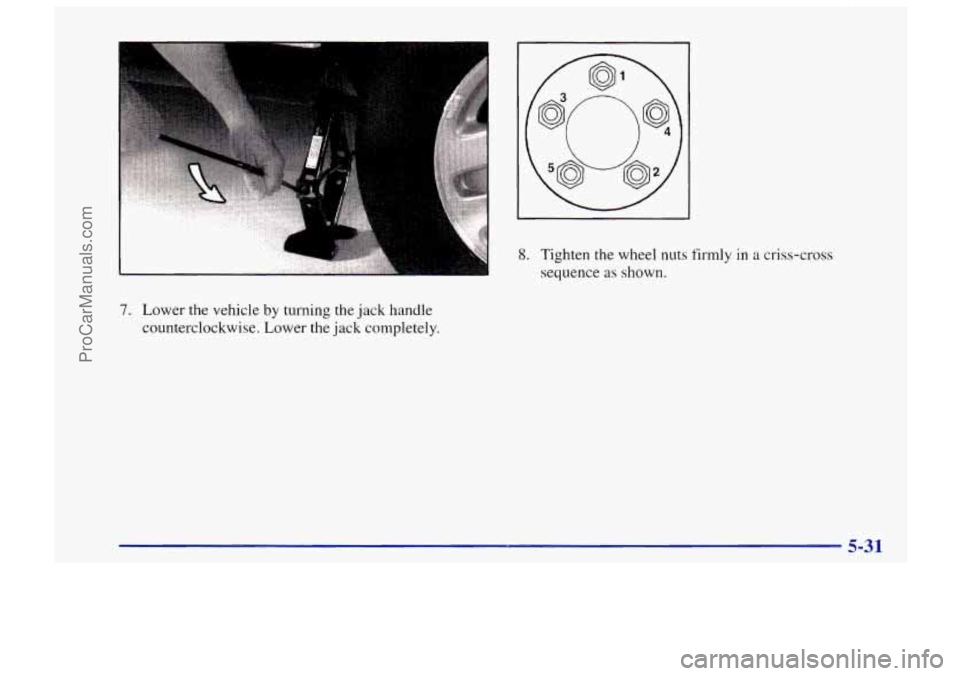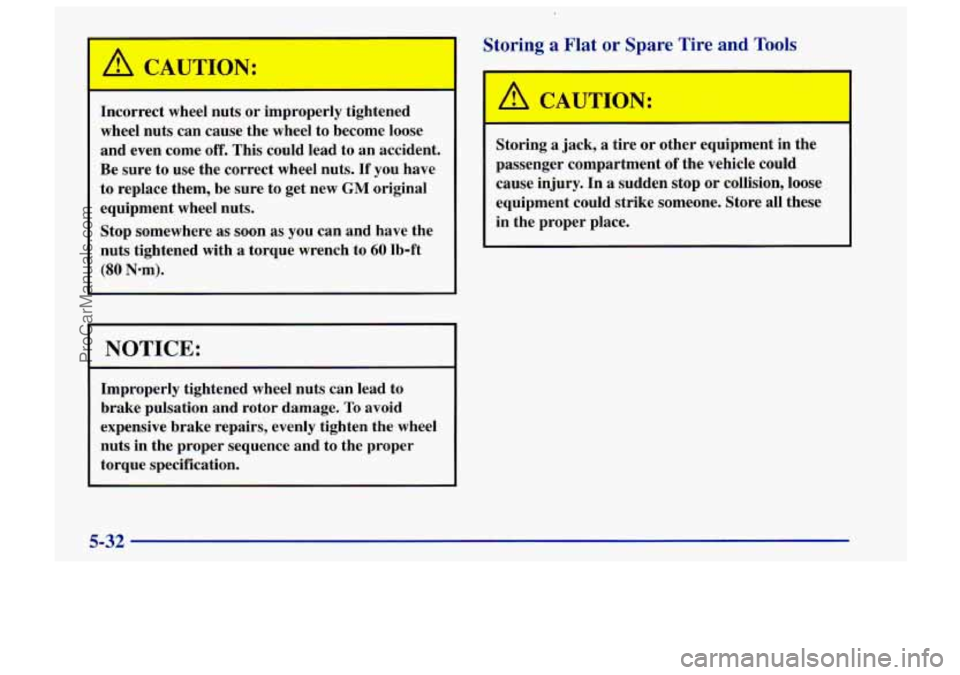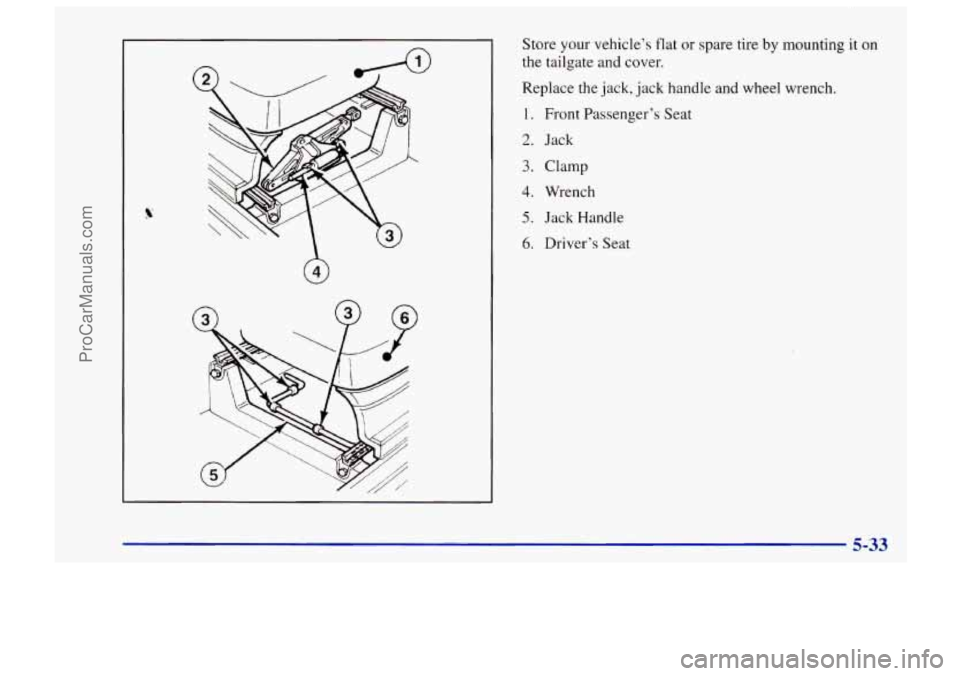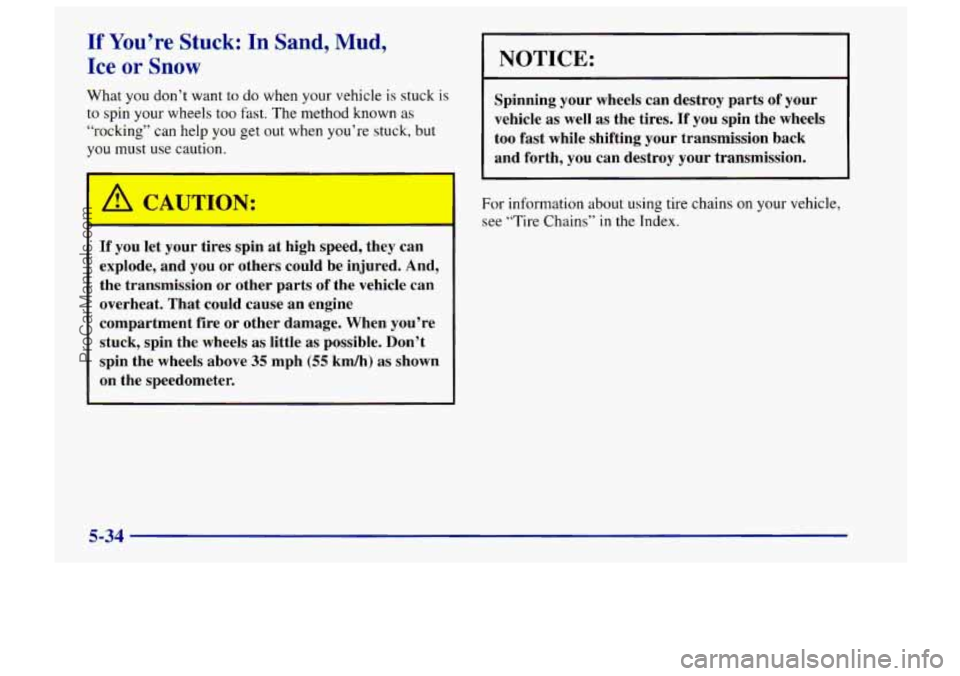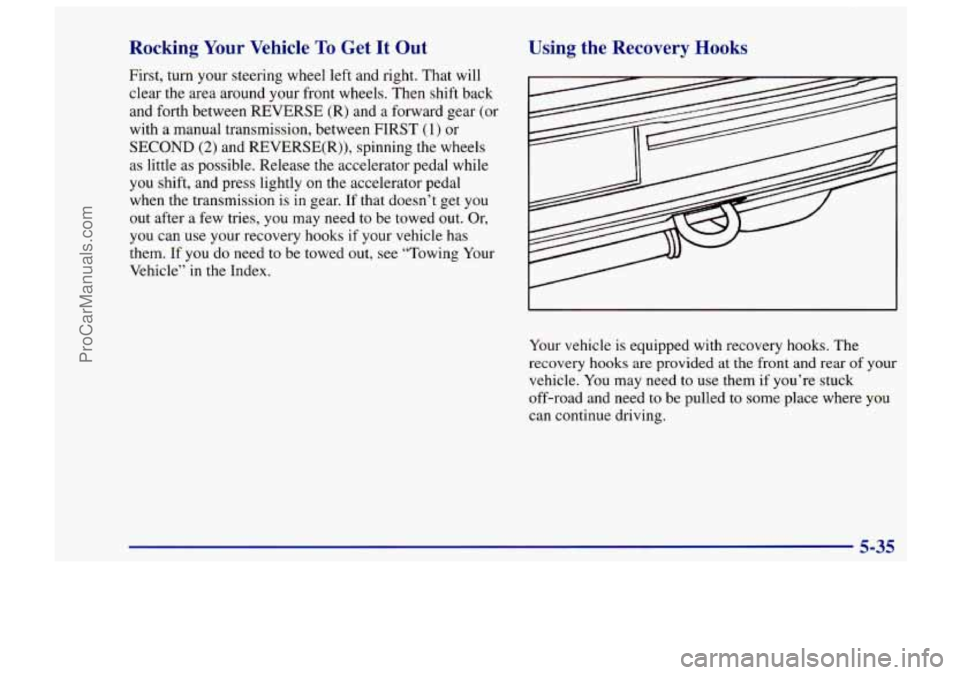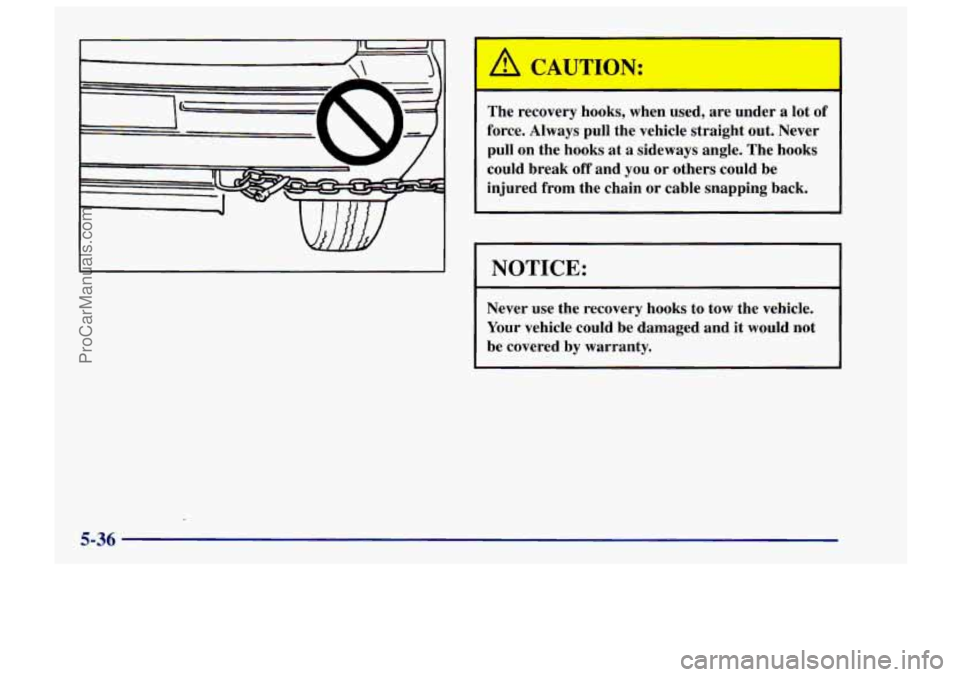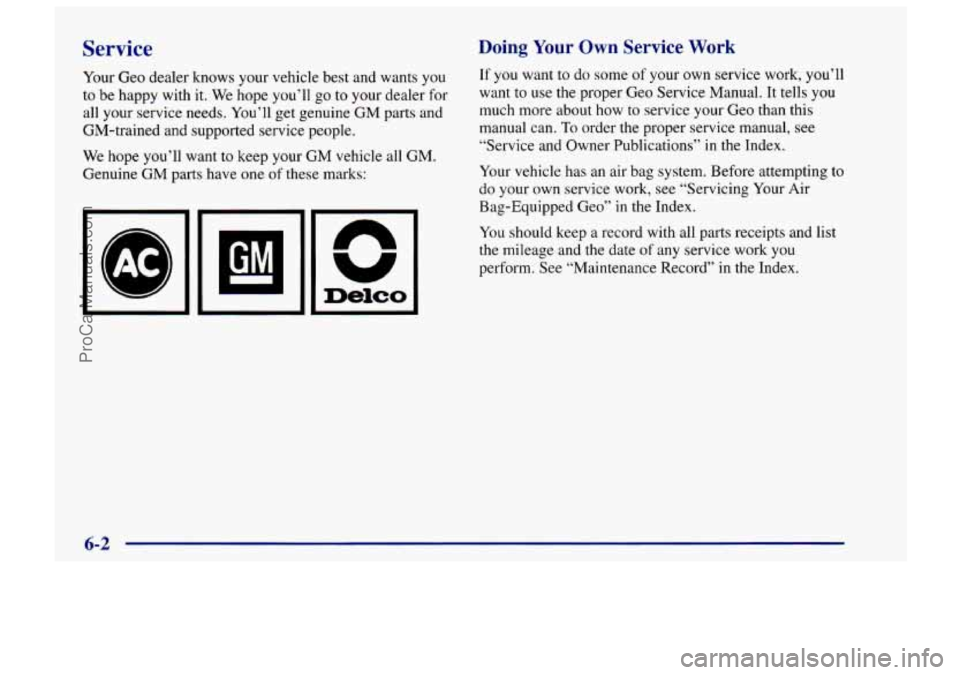CHEVROLET TRACKER 1997 Owners Manual
TRACKER 1997
CHEVROLET
CHEVROLET
https://www.carmanualsonline.info/img/24/57722/w960_57722-0.png
CHEVROLET TRACKER 1997 Owners Manual
Trending: check engine light, child restraint, radiator, warning, tow, wheel bolts, radio antenna
Page 231 of 388
4. Remove all the wheel
nuts and take off the
flat tire.
3. Raise the vehicle by turning the jack handle
clockwise. Raise the vehicle far enough
off the
ground
so there is enough room for the spare
tire to fit.
5. Remove any rust or dirt
from the wheel bolts,
mounting surfaces and
spare wheel.
5-29
ProCarManuals.com
Page 232 of 388
A CAUTION:
- -
Rust or dirt on the wheel, or on the parts to
which it is fastened, can make the wheel nuts
become loose after
a time. The wheel could come
off and cause an accident. When you change
a
wheel, remove any rust or dirt from the places
where the wheel attaches to the vehicle. In an
emergency, you can use a cloth or
a paper towel
to do this; but be sure to use a scraper or wire
brush later, if
you need to, to get all the rust or
dirt off.
/!1 CAUTION:
Never use oil or grease on studs or nuts. If you
do, the nuts might come loose. Your wheel could
fall off, causing a serious accident.
6. Replace the wheel nuts with the rounded end of the
nuts toward the wheel. Tighten each nut
by hand
until the wheel is held against the hub.
5-30
ProCarManuals.com
Page 233 of 388
a 8. Tighten the wheel nuts firmly in a criss-cross
sequence
as shown.
7. Lower the vehicle by turning the jack handle
counterclockwise. Lower the jack completely.
5-31
ProCarManuals.com
Page 234 of 388
I 6b, CAUTION:
Incorrect wheel nuts or improperly tightened
wheel nuts can cause the wheel to become loose
and even come off. This could lead to an accident.
Be sure to use the correct wheel nuts. If you have
to replace them, be sure to get new
GM original
equipment wheel nuts.
Stop somewhere
as soon as you can and have the
nuts tightened with
a torque wrench to 60 lb-ft
(80 Nom).
1 NOTICE:
Improperly tightened wheel nuts can lead to
brake pulsation and rotor damage.
To avoid
expensive brake repairs, evenly tighten the wheel
nuts in the proper sequence and to the proper
torque specification.
Storing a Flat or Spare Tire and Tools
I ' A CAUTION:
Storing a jack, re or other equipment in the
passenger compartment of the vehicle could
cause injury. In
a sudden stop or collision, loose
equipment could strike someone. Store all these
in the proper place.
5-32
ProCarManuals.com
Page 235 of 388
Store your vehicle’s flat or spare tire by mounting it on
the tailgate and cover.
Replace the jack, jack handle and wheel wrench.
1. Front Passenger’s Seat
2. Jack
3. Clamp
4. Wrench
5. Jack Handle
6. Driver’s Seat
5-33
ProCarManuals.com
Page 236 of 388
If You’re Stuck: In Sand, Mud,
Ice or Snow
What you don’t want to do when your vehicle is stuck is
to spin your wheels too fast. The method known as
“rocking’’ can help you get out when you’re stuck, but
you must use caution.
If you let your tires spin at high speed, they can
explode, and you
or others could be injured. And,
the transmission or other parts of the vehicle can
overheat. That could cause an engine
compartment fire or other damage. When you’re
stuck, spin the wheels as little as possible. Don’t
spin the wheels above
35 mph (55 kmk) as shown
on the speedometer.
I NOTICE:
Spinning your wheels can destroy parts of your
vehicle as well as the tires.
If you spin the wheels
too fast while shifting your transmission back
and forth, you can destroy your transmission.
For information about using tire chains on your vehicle,
see “Tire Chains”
in the Index.
5-34
ProCarManuals.com
Page 237 of 388
Rocking Your Vehicle To Get It Out
First, turn your steering wheel left and right. That will
clear the area around your front wheels. Then shift back
and forth between REVERSE
(R) and a forward gear (or
with a manual transmission, between FIRST (1) or
SECOND
(2) and REVERSE(R)), spinning the wheels
as little
as possible. Release the accelerator pedal while
you shift, and press lightly
on the accelerator pedal
when the transmission is
in gear. If that doesn’t get you
out after a few tries, you may need
to be towed out, Or,
you can use your recovery hooks if your vehicle has
them. If you do need to be towed
out, see “Towing Your
Vehicle”
in the Index.
Using the Recovery Hooks
Your vehicle is equipped with recovery hooks. The
recovery hooks are provided
at the front and rear of your
vehicle. You may need to
use them if you’re stuck
off-road and need to be pulled
to some place where you
can continue driving.
5-35
I
ProCarManuals.com
Page 238 of 388
A CAUTION:
The recovery hooks, when used, are under a lot of
force. Always pull the vehicle straight out. Never
pull on the hooks at
a sideways angle. The hooks
could break off and you
or others could be
injured from the chain
or cable snapping back.
I NOTICE:
Never use the recovery hooks to tow the vehicle.
Your vehicle could be damaged and it would not
be covered by warranty.
5-36
ProCarManuals.com
Page 239 of 388
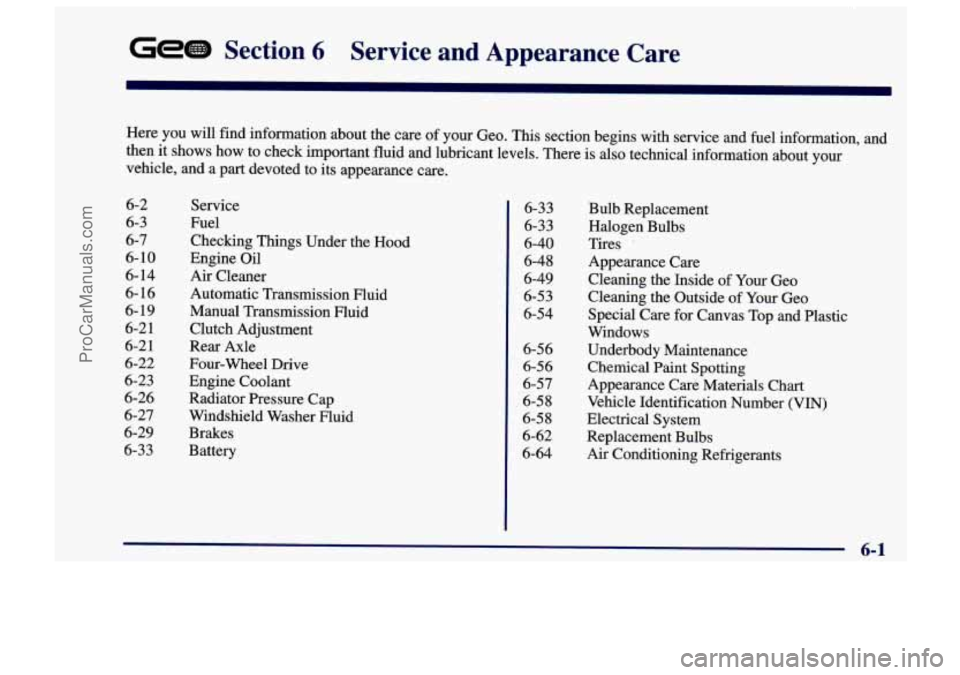
GE4iB Section 6 Service and Appearance Care
Here you will find information about the care of your Geo. This section begins with service and fuel information, and
then it shows how to check important fluid and lubricant levels. There is also technical information about your
vehicle, and a part devoted to its appearance care.
6-2
6-3
6-7
6-10
6- 14
6- 16
6-19
6-2 1
6-2
1
6-22
6-23
6-26
6-27
6-29
6-33
Service
Fuel
Checking Things Under the
Hood
Engine Oil
Air Cleaner
Automatic Transmission Fluid
Manual Transmission Fluid
Clutch Adjustment
Rear Axle
Four-wheel
Drive
Engine Coolant
Radiator Pressure Cap
Windshield Washer Fluid
Brakes
Battery
6-33
6-3
3
6-40
6-48
6-49
6-53
6-54
6-56
6-56
6-57
6-58
6-58
6-62
6-64
Bulb Replacement
Halogen Bulbs
Tires
'
Appearance Care
Cleaning the Inside of Your Geo
Cleaning the Outside of Your Geo
Special Care for Canvas Top and Plastic
Windows
Underbody Maintenance
Chemical Paint Spotting
Appearance Care Materials Chart
Vehicle Identification Number
(VIN)
Electrical System
Replacement Bulbs
Air Conditioning Refrigerants
6-1
ProCarManuals.com
Page 240 of 388
Service
Your Geo dealer knows your vehicle best and wants you
to be happy with it. We hope you’ll go to your dealer for
all your service needs. You’ll get genuine
GM parts and
GM-trained and supported service people.
We hope you’ll want to keep your GM vehicle all
GM.
Genuine GM parts have one of these marks:
Delco
Doing Your Own Service Work
If you want to do some of your own service work, you’ll
want to use the proper Geo Service Manual. It tells you
much more about how to service your Geo than this
manual can.
To order the proper service manual, see
“Service and Owner Publications” in the Index.
Your vehicle has an air
bag system. Before attempting to
do your own service work,
see “Servicing Your Air
Bag-Equipped Geo” in the Index.
You should keep a record with all parts receipts and list
the mileage and the date
of any service work you
perform. See “Maintenance Record” in the Index.
6-2
ProCarManuals.com
Trending: maintenance schedule, glove box, manual radio set, oil, wheel alignment, warning lights, winter tires
